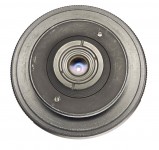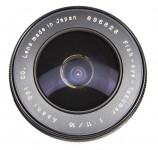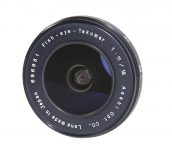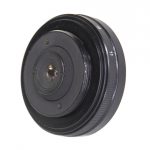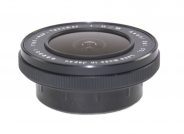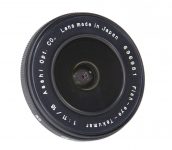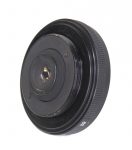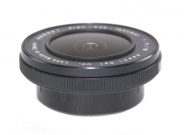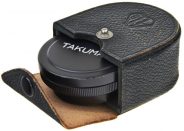Asahi Fisheye-Takumar 18mm F/11
Fisheye lens • Film era • Discontinued
- Announced:
- · 1963
- Production status:
- ● Discontinued
- Country of design:
- · Japan
- Original name:
- · Asahi Opt. Co. Fish-eye-Takumar 1:11/18
- Order No.:
- · 356
- · 43560
- Class:
- · Ultra-slow full-frame diagonal fisheye lens
- · Pancake lens
- System:
- · Asahi Pentax M42 (1957)
Abbreviations
| FISHEYE | An ultra-wide angle lens with strong uncorrected barrel distortion and extreme angle of view. |
Specification
| Optical design: | |
| 35mm full frame | |
| 18mm | |
| F/11 | |
| 4 elements in 3 groups | |
| Fixed focus | |
| Diagonal (full-frame) fisheye | |
| M42 [45.5mm] | |
| 180° | |
| Diaphragm mechanism: | |
Diaphragm type: | Manual |
Aperture control: | Aperture ring |
| Focusing: | |
| 0.25m | |
| <No data> | |
Manual focus control: | None |
| Physical characteristics: | |
| 98g | |
| ⌀60×12mm | |
| Accessories: | |
| Removable front filters are not accepted | |
| Not available | |
| Not available |
Sources of data
- The Ultimate Asahi Pentax Screw Mount Guide 1952-1977 book by Gerjan van Oosten (1999).
- Lenses for the Honeywell Pentax booklet (October, 1965).
- Complete system of photography: Asahi Pentax lenses and accessories booklet (PUB. 63008).
- Asahi Pentax SV & S1a operating manual (PUB. 61008, 18 pages).
- Honeywell Pentax H3v/H1a operating manual.
- Honeywell Pentax Spotmatic operating manual (May 1967).
Manufacturer description #1
The widest wide-angle lens - lighter and more compact than any made - covers an angle of vision of about 180°.
Manufacturer description #2
Unlike many other ultra-wide-angle lenses, the Takumar 18mm lens affords actual through-the-lens viewing, permitting the photographer to view the subject and compose the picture through the viewfinder of the Pentax. No rangefinders or attachments are needed!
Extremely compact and lightweight, the 18mm Takumar becomes an effective tool in the hands of the creative photographer who utilizes the barrel distortion deliberately incorporated into its design.
From the Camera 35 magazine (December 1967/January 1968)
Even though this lens is officially called a Fish-eye, it does not produce a round image as with the famous Nikkor lens. However, it does everything else. The reason for the seemingly unimpressive resolution figures is also due to its fisheye design. The same performance yardstick for regular lenses should not be applied to these special effect lenses. This is a fun lens, since it is so compact and you can actually look through it to get the full fisheye effect... a control not possible with some similar lenses. Also, since it is manual lens, it can be used, with adapters, on many other SLR cameras.
Typical characteristics of fisheye lenses
- Extreme angle of view (at least 180° diagonally);
- Circular types (the image circle of the lens is inscribed in the image frame) or diagonal types (cover the entire image frame);
- Usually of equidistant projection type, with the distance from the picture center to any given point always proportional to the angle from the optical axis to that point;
- Huge barrel distortion;
- Short closest focusing distance (0.20 - 0.30m with 35mm full-frame prime lenses);
- Very large depth of field, eliminating the need for autofocus or precise manual focusing;
- Due to the extreme angle of view and convex front element, front filters cannot be used;
- Often equipped with a filter turret with swivel-mounted filters;
- Often come with a small, built-in petal-shaped lens hood.
From the editor
Fish-eye TAKUMAR 18mm F/11, introduced by Asahi Optical Co., Ltd. in 1963, was the world's first full frame (diagonal) fisheye lens. It is a very compact and lightweight “pancake” lens with diagonal angle of view of 180 degrees. Unfortunately also a very slow lens, which image circle doesn't quite cover the extreme corners of the frame.
This is the only lens in the Asahi TAKUMAR M42 lineup which uses Waterhouse diaphragm (invented by John Waterhouse of Halifax in 1858 according to the Cassell's Cyclopedia of Photography 1911), a set of perfectly round holes with varying sizes corresponding to f-stops. The needed stop – 11, 16, 22 or 32 - can be chosen by rotating the diaphragm ring. The rest of the Asahi TAKUMAR M42 lenses all have iris diaphragms.
The lens features fixed focus design: there is no focusing ring and everything is in focus from the closest focusing distance of 25 cm to infinity.
The lens does not have a filter thread or a gelatin filter holder at the back. There are no built-in filters. The lens hood is also not available.
Despite having 4 elements in 3 groups, the optical formula of this lens is not of Tessar type famous for its very good optical performance. The slow speed of f/11 does not help either, because diffraction starts to affect the overall sharpness already from the maximum aperture and the image quality only becomes worse with further closing of the aperture.
Other fisheye lenses in the Asahi Pentax M42 system
| ■M42 mount (2) | |||||||||
| Asahi Fisheye-Takumar 17mm F/4 [43841] | A | 11 - 7 | 0.20m | -- | 1967 ● | ||||
| Asahi Super-Multi-Coated Fisheye-Takumar 17mm F/4 [43842] | A | 11 - 7 | 0.20m | -- | 1973 ● | ||||
Lenses with similar focal length
| ■M42 mount (6) | |||||||||
| Fuji Photo Film EBC Fujinon 16mm F/2.8 Fisheye | A | 12 - 8 | 0.25m | -- | ● | ||||
| Sigma MF 16mm F/2.8 Filtermatic Fisheye Multi-Coated | A | 9 - 8 | 0.15m | -- | 1980 ● | ||||
| Sigma[-XQ] MF 16mm F/2.8 Filtermatic Fisheye Multi-Coated | A | 11 - 9 | 0.15m | -- | 1978 ● | ||||
| Zodiak-2M-2 15mm F/3.5 Fisheye MC akaМС ЗОДИАК-2М-2 15mm F/3.5 | A | 9 - 5 | 0.20m | -- | 1979 ● | ||||
| Zenitar 16mm F/2.8 Fisheye MC akaЗЕНИТАР-К 16mm F/2.8 РЫБИЙ ГЛАЗ МС akaЗЕНИТАР-М 16mm F/2.8 РЫБИЙ ГЛАЗ МС akaЗЕНИТАР-Н 16mm F/2.8 РЫБИЙ ГЛАЗ МС | A | 11 - 7 | 0.30m | -- | 1990 ● | ||||
| Zenitar 16mm F/2.8 Fisheye MC | A | 11 - 7 | 0.30m | -- | ● | ||||
| ■Interchangeable mount (2) | |||||||||
| Sigma[-XQ] MF 16mm F/2.8 Filtermatic Fisheye Multi-Coated [YS] | A | 11 - 8 | 0.15m | -- | 1973 ● | ||||
| BelOMO Peleng A 17mm F/2.8 Fisheye MC [T] akaБелОМО ПЕЛЕНГ А 17mm F/2.8 МС РЫБИЙ ГЛАЗ | P | ? - ? | 0.30m | -- | ● | ||||

